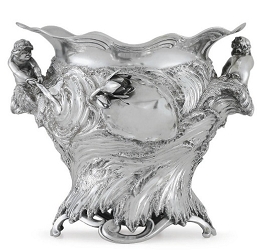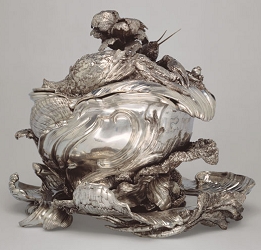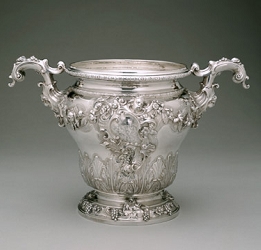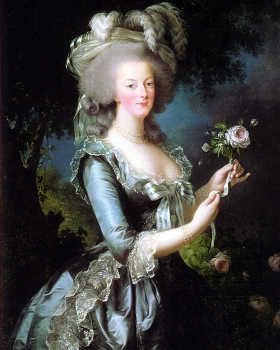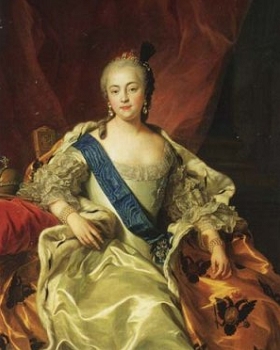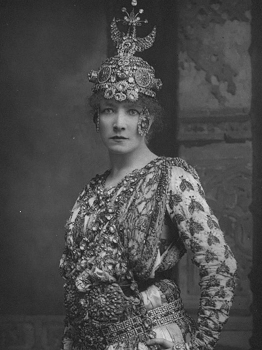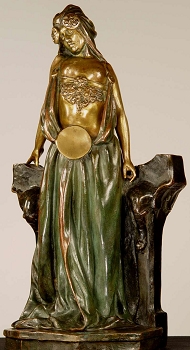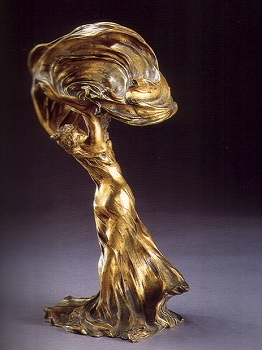Naturalistic Sensuous Lines from Rococo to Art Nouveau
The essence of Art Nouveau style (1895-1910) is described by naturalistic sensuous lines derived from vegetal curves and willow leaves, subtle light, feminine figures and curly hair, fluent dresses and attitudes, twisting waves and evanescent smoke, but also by controlled lines, geometric details, colorful new shapes.
And also Art Nouveau was inspired by the idea of "total art".
These characteristics are also seen in the essence of Rococo style. Some critics interpret the Art Nouveau style as a turn-of-the-centnry reinvention of the Rococo.
The movement's inspiration was pastoral and earthly by nature. Art Nouveau shares the naturalism with Rococo in different dimensions.
Generally said, Naturalism in art refers to the depiction of realistic objects in a natural setting. In this context, Naturalism began in the early Renaissance, and developed itself further throughout the Renaissance, such as with the Florentine School.
Naturalism is the generic term for Art Nouveau, Organic Architecture and Expressionism of which styles overlap one another and were often only a stage in an architects working span.
Architecture
 Alexandre Charpentier (1856-1909), Dining room set of the banker Adrien Bénard in Champrosay, 1901. Mahogany, oak and poplar; metalwork of gilt bronze; Flower stand of enamelled stoneware. Paris, Musée d’OrsayNaturalism is the generic term for Art Nouveau, Organic Architecture and Expressionism of which styles overlap one another and were often only a stage in an architects working span.
Alexandre Charpentier (1856-1909), Dining room set of the banker Adrien Bénard in Champrosay, 1901. Mahogany, oak and poplar; metalwork of gilt bronze; Flower stand of enamelled stoneware. Paris, Musée d’OrsayNaturalism is the generic term for Art Nouveau, Organic Architecture and Expressionism of which styles overlap one another and were often only a stage in an architects working span.
It all started in 1861 in England, the most industrialized country at the time, where William Morris in collaboration with other artists, created the Arts and Crafts Movement as a reaction to the mid-19th-century artistic styles.
Following socialist ideas, they wanted an art for everyone, all objects being of beauty and of use and had to be handmade.
They did not completely succeed, as hand production was too expensive for the masses, but schools, exhibitions and magazines largely diffused those ideas and they created a favourable environment for the birth of Art Nouveau.
Many artists, architects, designers and intellectuals in all forms of decorative and visual arts, as well as cultural and avant-garde fields, explored the idea to create an "art of modern life".
In 1893, greatly influenced by the ideas of Morris, a young Belgian Architect Victor Horta, began to plan the first important house to be built in Art Nouveau Style : la Maison Tassel.
 A delicacy of decorative motif in paneling and furniture characteristic of the Rococo design of the Louis XV style; room from the Hôtel de Varengeville, Paris. Courtesy of the Metropolitan Museum of Art, New YorkIn 1894, also in Brussels, Henri van de Velde published the pamphlet "le Déblaiement d’Art", in which he developed new and nearly revolutionary ideas relating to fine arts and decorative arts, whereas architecture and interior design had to rise to the status of a total work of art. A year later in 1895, in Paris, the pioneer city of so many world affecting art forms, the name of the Movement -Art Nouveau- was finally settled in the French language. In particular because of the art gallery "La Maison de l'Art Nouveau", which was opened as a showroom for the new art by a Japanese art collector, Siegfried Bing. Paris added also a touch of glamour to Art Nouveau with the "Divine" Sarah Bernhardt and her protégés: Alfons Mucha and jewellery and perfume bottles designer René Lalique.
A delicacy of decorative motif in paneling and furniture characteristic of the Rococo design of the Louis XV style; room from the Hôtel de Varengeville, Paris. Courtesy of the Metropolitan Museum of Art, New YorkIn 1894, also in Brussels, Henri van de Velde published the pamphlet "le Déblaiement d’Art", in which he developed new and nearly revolutionary ideas relating to fine arts and decorative arts, whereas architecture and interior design had to rise to the status of a total work of art. A year later in 1895, in Paris, the pioneer city of so many world affecting art forms, the name of the Movement -Art Nouveau- was finally settled in the French language. In particular because of the art gallery "La Maison de l'Art Nouveau", which was opened as a showroom for the new art by a Japanese art collector, Siegfried Bing. Paris added also a touch of glamour to Art Nouveau with the "Divine" Sarah Bernhardt and her protégés: Alfons Mucha and jewellery and perfume bottles designer René Lalique.
Between 1892 and 1897, the Symbolism Movement flourished in France and Belgium, whereas painters such as Odilon Redon and Ferdinand Knopf explored mystical and metaphysical themes, and they deeply influenced Art Nouveau artists and designers, such as the illustrator Alfons Mucha or the glassware designer Emile Gallé.
A wider attention was brought out to Art Nouveau during the World Exhibition held in Paris in 1900 and by the opening of its subway "le Metropolitain", the entrances of which were created by French architect-designer Hector GUIMARD. At the beginning of the new century, the expansion of Art Nouveau was massive in Western Europe, it developed especially in the provincial cities, as capital cities resisted to the new art, in Glasgow more than London, in Darmstadt or Munchen more than Berlin, Nancy more than Paris, Barcelona, Milan, but also in Prague, Vienna, Helsinki and of course Brussels. The works and aesthetics of artists-designers such as the painter Gustav KLIMT and the architect Josef HOFFMANN, the designer Joseph Maria OLBRICH in Austria; the Scottish architect Charles Rennie MACKINTOSH; the "visionary" Catalan architect Antoni GAUDÍ I CORNET; the Spanish fashion designer established in Italy Mariano FORTUNY Y MADRAZO; the German illustrator Otto Eckmann and the architect Peter Behrens; the originator of the ornamental Floreale style Giuseppe Sommaruga or designer Carlo Bugatti in Italy, and many others, were broadly exposed on the international cultural scenes and their styles became widely known.
The Art Nouveau Movement reached at a later stage the cities of Chicago, Boston and New York in northern United States, where Louis Comfort TIFFANY is considered the only original Art Nouveau artist in the decorative field and Louis Sullivan in architecture, is considered the precursor of America's greatest architect, Frank Lloyd WRIGHT.
The First World War (1914-1918) marked the end of the Art Nouveau style.
The world had changed and with it the mentalities.
The elegance, sensuality, flamboyance of Art Nouveau was going to be substituted by more rational styles as Art Deco and Bauhaus all influenced by one of the major cultural and artistic movements of the 20th-century.
Creative Muse
Sensual lines in Rococo style symbolize Grace, in Art Nouveau Emotion.
Rococo
The feminine look of the Rococo style suggests that the age was dominated by the taste and the social initiative of women to a large extent it was. Ladies -- Madame de Pompadour (Jeanne-Antoinette Poisson: 1721–1764) in France, Maria Theresa in Austria (1717–1780), Elizabeth of Russia (1709-1762) and Catherine the Great (1729-1796) in Russia, who held some of the highest positions in Europe, were the creative muse for Rococo artists. Noble gentility and delicacy of Rococo style tried to symbolize and depict inner beauty of these ladies. On the other hand the characteristics of Rococo reflected the mental tendency of the French bourgeoise. They luxuriated in a new artistic freedom, indulged their highly individualistic tastes, and welcomed fresh ideas in decoration. A society devoted to material comfort and preoccupied with personal pleasure demanded constant variety, surprise, and originality. The French nobles abandoned Versailles after 1715 for the pleasures of town life. The "hotels" (town houses) of Paris soon became the enters of a new, softer style we call "rococo." Vivid sensual seduction can be observed on works on paintings by Jean-Honoré Fragonard and François Boucher.
Art Nouveau - Sarah Bernhardt
Sarah Bernhardt (1844–1923), a stage and early film actress, was the most powerful creative muse in Art Nouveau periood. Her strong emotional seduction inspired the creativity of many artists like Alphonso Mucha and induced many men to sensual affairs with her, including a son of Eugène, 8th Prince of Ligne, Charles-Joseph Eugène Henri Georges Lamoral de Ligne (she had her only child with him), the great French writer Victor Hugo, the actor Lou Tellegen, and the prince of Wales, the future Edward VII, and also she grasped the heart of the era.
Unconsciously artists might try to depict his own wave of emotion piercing sensual instincts by symbolizing the waving sensuous lines which characterize Art Nouveau.
Eroticism & Mass-Marketing
 The Prey Vase designed by Auguste Ledru (1860-1902), 1895. Patinated bronze
W: 35.4 cm x H: 44 cm. Victoria & Albert MuseumThe erotic nature of many Art Nouveau works is one of the most prevalent features of the style. Nowhere is it more abundantly seen than in small-scale sculptural or decorative arts objects such as ink-wells, carafes, centrepieces, candelabra, lamps and figurines - the kind of objects that were disseminated widely and could be brought into any middle-class household. The eroticism of these objects is made all the more complex by their utility and domesticity. They often demand physical engagement: furniture or carafes where the handles are naked women that must be grasped; vessels that metamorphose into women inviting touch; lamps that provocatively pose women in suggestive positions. These erotically charged objects, unlike most sculpture, demand contact. The theme of objects fulfilling a sexual need was not a new one, although it found particular resonance in the fin de siècle. The fetishistic concentration on the erotic potential of the object is implicit in much Art Nouveau. Many Art Nouveau decorative arts objects manipulated the female body to create different and often playful symbolic narratives. The scale of the production and dissemination of these kinds of objects denoted a widespread 'taste for the erotic', not only among upper-class and aristocratic collectors of the more explicit and expensive objects, but also by the middle classes, concerned to achieve the height of modern decorative style in their homes. During this period the erotic briefly came to denote the modern.
The Prey Vase designed by Auguste Ledru (1860-1902), 1895. Patinated bronze
W: 35.4 cm x H: 44 cm. Victoria & Albert MuseumThe erotic nature of many Art Nouveau works is one of the most prevalent features of the style. Nowhere is it more abundantly seen than in small-scale sculptural or decorative arts objects such as ink-wells, carafes, centrepieces, candelabra, lamps and figurines - the kind of objects that were disseminated widely and could be brought into any middle-class household. The eroticism of these objects is made all the more complex by their utility and domesticity. They often demand physical engagement: furniture or carafes where the handles are naked women that must be grasped; vessels that metamorphose into women inviting touch; lamps that provocatively pose women in suggestive positions. These erotically charged objects, unlike most sculpture, demand contact. The theme of objects fulfilling a sexual need was not a new one, although it found particular resonance in the fin de siècle. The fetishistic concentration on the erotic potential of the object is implicit in much Art Nouveau. Many Art Nouveau decorative arts objects manipulated the female body to create different and often playful symbolic narratives. The scale of the production and dissemination of these kinds of objects denoted a widespread 'taste for the erotic', not only among upper-class and aristocratic collectors of the more explicit and expensive objects, but also by the middle classes, concerned to achieve the height of modern decorative style in their homes. During this period the erotic briefly came to denote the modern.
'The Prey', vase, Auguste Ledru, 1895. The end of the century saw the advent of mass advertising. Chromolithography as an artistic medium provided possibilities for mass communication that printers and artists were quick to take advantage of. Perhaps the most crucial development for advertising in the 20th century was the realisation that the successful advertisement sold an idea or lifestyle rather than a product - and sex sold products better than anything else. Just as the promise of sex could fill the theatres of Paris, so sex could sell anything from cigarettes and cars to painting and poetry. Designers also were selling the idea of a sophisticated, decorative and glamorous identity to women - increasingly the dominant consumers. As it was women who often held the domestic purse strings, it was they who came to be associated with shopping.
 Ples by A. Mucha.Many Art Nouveau poster designers used a veiled but highly charged eroticism and none more successfully than Alphonse Mucha, who created images of woman that epitomised the sophisticated and decorative Art Nouveau woman. His posters commodifed women, making them the ultimate symbol of the modern consumer world. His strategy of combining women with products sold a lifestyle dream, just as lifestyle became an issue for a growing metropolitan middle class with a disposable income. Many designers used women to sell products. Designers often used the male body to promote industry and technology, while the female body was used for product and entertainment.
Ples by A. Mucha.Many Art Nouveau poster designers used a veiled but highly charged eroticism and none more successfully than Alphonse Mucha, who created images of woman that epitomised the sophisticated and decorative Art Nouveau woman. His posters commodifed women, making them the ultimate symbol of the modern consumer world. His strategy of combining women with products sold a lifestyle dream, just as lifestyle became an issue for a growing metropolitan middle class with a disposable income. Many designers used women to sell products. Designers often used the male body to promote industry and technology, while the female body was used for product and entertainment.
The Oscar Wilde trials of 1895 were tremendously significant, spectacularly bringing the reality of homosexuality into the open. For some, Wilde became a martyr, a pivotal figure around whom homosexual identity was formed, while for others he became the symbol of unhealthy decadence. Decadence had become increasingly associated with non-conformity. Art Nouveau's association with decadence in the public mind undoubtedly contributed to the rejection of the style in the new century.
Art Nouveau style was short-lived, collapsing finally in the years prior to the First World War. The erotic content of so many Art Nouveau objects was undoubtedly a significant factor in its demise. The fundamental subversiveness of eroticism, its disregard for conventional morality or social structures, was recognised as a destabilising factor across the ideological spectrum. Both socialist International Modernism and conservative historicism ignored the exploration of sexuality, deliberately pushing it to the periphery of art and design debates.
Functionality and technological progression came to signify modernity, dominating the new century's design agenda, while the unadulterated use of historical styles once more signalled stability. However, although absent from the male-dominated sphere of Bauhaus or Le Corbusian functionalism, the erotic could not entirely be eradicated. Its reappearance in Surrealism and Art Deco demonstrates the power of the erotic to explore, simultaneously, the body and mind.
 Job by Mucha Job by Mucha |  Fruit by Mucha Fruit by Mucha |
 Jesen - Autumn by Mucha Jesen - Autumn by Mucha | 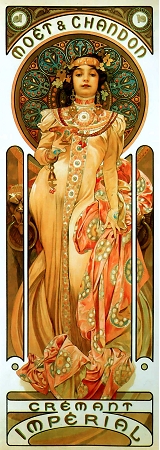 Advertizement Moet et Chandon by Mucha Advertizement Moet et Chandon by Mucha |
|
|
 Top
Top Site Map
Site Map References
References About Me
About Me